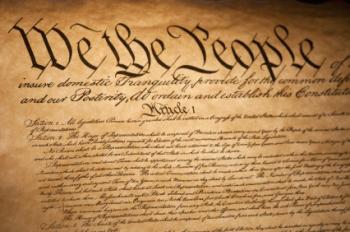How has the United States Constitution lasted for 228 years?
Politicians, soldiers, and police routinely take oaths promising to “uphold and defend” the United States Constitution. Newly naturalized Americans pledge “allegiance” to it. It is referenced in discussions about every important national issue, ranging from immigration to gay rights. And, though the Constitution is the “supreme law of the land,” few have ever actually read it. Even fewer can tell you how it was adopted. Yet the method of its adoption largely accounts for why our Constitution has lasted for more than two centuries … longer than any other on the planet.
The U.S. Constitution is the shortest constitution governing any country in the world today. Without signatures or amendments, it is just 4,400 words, about 15 double-spaced typewritten pages. Compare that with the recent Affordable Care Act (“Obamacare”), which is more than 381,000 words or about 1,300 pages. Although written 228 years ago, most of the Constitution’s language remains readable today and, with few exceptions, the concepts it embodies are understandable by almost anyone over 16. If you take the 30 minutes necessary to read the Constitution, you will be surprised both about what it does say and what it doesn’t, and will find your understanding of current events to be greatly informed.
Upon being drafted, the U.S. Constitution was adopted through a four-step procedure starting in 1787 and taking almost four years to complete. The critical step, however, was the popular election of special delegates to 13 state conventions, called solely to consider the ratification of the Constitution. Existing state legislatures were bypassed so that every delegate to each of the 13 state conventions would be elected directly by the people of their state. These special delegates would then vote at their state’s constitutional convention only on one monumental issue: whether to ratify the Constitution, thereby creating a new country—the United States of America.
The submission of the Constitution for ratification to the 13 individual state conventions ignited a huge national debate, which played out for several years in newspapers, pamphlets, and at street corners and town meetings. For the first time, the people of a entire region were being asked to decide for themselves the form of government they wanted. And they were required to look well beyond the borders of their own state to consider how best to govern a new country stretching more than 1,000 miles from Georgia to what is now Maine … a territory almost nine times the size of England.
The final step of adoption was spelled out in Article VII of the Constitution itself. Once a supermajority of the state conventions, nine out of 13, voted for ratification, the Constitution would become law in those states that had approved it. Nothing else was required. The Constitution automatically took effect when the ninth state ratified it in 1789, and elections began to be organized for the offices it created: a president, vice-president, senators and representatives. Ultimately, all 13 states voted in favor of ratification.
Developing a broad national consensus by submitting the U.S. Constitution for approval effectively by the people themselves is an overlooked but brilliant aspect of the work of the Founding Fathers in creating our country. Forging that national consensus is the principle reason why the Constitution has been able to endure in a changing world for more than two centuries. In enacting laws affecting all Americans, today’s politicians would do well to heed the example of creating a consensus provided by the adoption of the U.S. Constitution.




























.png)

.png)
